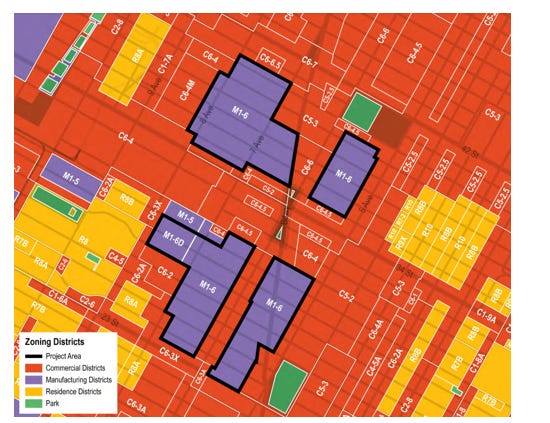Director and Chair of Dept. Of NYC Planning Dan Garodnick and NYC Mayor Adams recently secured preliminary approvals for the Midtown South Mixed-Use (MSMX) Plan. Initial plans for the rezoning began in the summer of 2023 with the idea of leveraging the district's proximity to transit and jobs and the high vacancy rates in B and C office buildings to create housing. The plan is to enable the development of just under 10,000 homes, adjust the NYC zoning map, and make a zoning text amendment.
The area is ripe for a rezoning because:
As seen below, the coverage area is close to Penn Station, the Port Authority Bus Terminal, Herald Square, and Bryant Park and within 5-10 minutes of Long Island City, Grand Central, and Hudson Yards on the train.

Source: MSMX rezoning plan The zoning laws in the rezoning area require manufacturing uses (light blue). Most of the zoning in the surrounding areas limits property uses to only commercial functions like offices (red), and the yellow highlighted areas reflect areas that currently allow for residential use. As the map shows, the current zoning reserves very few places for residential use.

Note: Current zoning in the region up for change. Source: MSMX rezoning plan NYC has shifted away from manufacturing jobs in the last ten years to embrace technology and "creative jobs" done on a computer and, perhaps, performed remotely. The United States has been a service-based economy for some time now, and the data in NYC reflect the continued trend of thought work vs. manual labor. According to the Department of City Planning, the area:
“is currently dealing with the challenges of commercial vacancies, changing work patterns, and decades-old zoning that severely limits new housing and opportunities for New Yorkers to live close to their jobs," which is what the new zoning aims to fix.

Source: MSMX rezoning plan
The City of Yes for Housing Opportunity (COYHO) Effect
But what’s even more exciting about the rezoning is that this will be the first neighborhood rezoning since COYHO's passing. The planners behind MSMX leveraged the looser FAR rules that COYHO and a recent state law amendment permitted and created new, never-before-seen zoning districts. R11 districts will have Floor to Area Ratios (FARs) of 15, and R12 districts will have FARs of 18. The additional density the plan wishes to grant across the 42 blocks comprising the subject area would enable newer development to match many older buildings whose FARs exceed the newer stock.
Artificially creating air rights like this will add value to properties and invite developers to reconsider past project opportunities. This anticipated growth in value comes at a time when class B and C office building owners find themselves with properties worth less than their mortgage values, which were at 50-75% LTV only six years ago before the pandemic. The change of zoning and use requirements will be game-changing for many owners who want to sell their buildings at par with loan values.
COYHO grants buyers and existing owners another significant benefit by eliminating the Dwelling Unit Factor (DUF). As of COYHO's approval in December, there is no cap on how many units can exist in a particular block of space. Light, air, core, and other requirements still exist, but in theory, there won't be any problems if properties are built with average unit sizes of 400-500 SF. Before the City of Yes, the calculation was more or less:
FAR x lot size = Total Buildable Square Feet
Total Buildable Square Feet / DUF of 680 (in R6 district and greater) = Total Number of Possible Units
This old policy restricted units, but now COYHO has eliminated DUF guidelines in Manhattan, allowing developers to build more units in a property than before. In theory, developers can now carve up their zoning floor areas for sites however they want, as long as they meet other zoning and building code requirements.
Overall Meaning for NYC Owners & Next Steps
The MSMX is significant even for owners without properties in the impacted areas because it will pave the way for future rezonings in NYC, such as the Long Island City and the Atlantic Avenue Mixed Use plans, which are currently mid-flight. The MSMX plan will be the first time NYC used zoning districts R11 and R12. In addition to having access to larger FARs, developers will be able to create more apartments per chunk of built space. This is like growing the numerator and shrinking the denominator. In isolation, raising FARs or increasing floor densities will grow potential unit counts on a development site, but taken in combination and, the number of units that plots of land can deliver really begins to grow. If MSMX succeeds in ULURP and leads to many new apartments, city planners could apply some of these same rules to Downtown Brooklyn, parts of Williamsburg, and many areas of Manhattan.
The plan has entered the Uniform Land Use Review Procedure (ULURP). ULURP is NYC's process for collecting and applying feedback from elected officials and community members before significant changes in the built environment are formally approved and implemented. If approved, the process takes about 150-215 days. I have written about some of the issues with the current ULURP process here and here. Next week, as reforms to the city charter are underway, I will explore some of these issues more in-depth.
Keep reading with a 7-day free trial
Subscribe to Romain Sinclair's NY Multifamily Newsletter to keep reading this post and get 7 days of free access to the full post archives.


